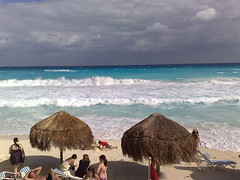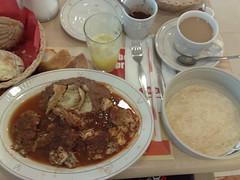- European tourists travel to be abroad, American tourists to be at home. Obvious when you compare the hotels catering to European and American tourists in Mexico.
Seaside guacamole economics
When I was still having fun and enjoying the sun, sea and sand in Cancún, I had an insight that may be good to explain the concept of added value.
Whereas the ingredients for a plate of guacamole would cost you around 15 pesos (1 EUR) if bought at the supermarket, when I ordered it at my hotel it costed more than 80 pesos (5 EUR). If we take into consideration that the different farmers got probably a few peso cents for selling the individual avocados, onions and other individual ingredients this begs the question: Why the increase?
For starters, I didn’t have to grow the crops myself. I didn’t have to go to the supermarket and buy the ingredients and I didn’t have to prepare it either. Furthermore, I was at the beach and had a very nice view.
All these extras are called added value. This is why higher profits are not in the production of raw materials, and why I think that the strategies being followed by many Latin American countries in focusing on extraction of raw materials are not right for the medium/long term.
American Spanish speakers
I was very pleasantly surprised when I found many Spanish-speaking WASP-looking Americans while visiting Cancún. Even though Spanish in the United States is still a minority language, it seems that at least for some people outside of the original native speakers it has become important to learn it.
Before the Spanish-language skills of Americans used to be a joke amongst Mexicans, now I'm not so sure.
Strong euro
With the current exchange rate, having expenses in US dollars or Mexican pesos and earning in euros is quite a nice value proposition. I could truly see that my money would last longer, and get more for it.
I have to say it was really nice since I already have a shopping list before arriving in the place.
Mexican breakfast
Most foreign visitors to Mexico (including Latin Americans) can’t understand how Mexicans eat that much for breakfast.
Instead of just coffee and a piece of bread, in Mexico you will start with a plate of fruit with or without a yoghurt topping, then move on to the main dish (usually eggs prepared in different ways, but might also be a spicy tripe soup or even a steak with nopales) accompanied witha glass of fruit juice and finally coffee and bread.
The best way to start the day. Comparing this to the Finnish institution of “riisipuuro” it’s no wonder they are hungry again at 11.
More chronicles on the Mexican breakfast available here, here, here and here.
Wasabi = guacamole?
Back in the 80's, when sushi was entering the Mexican market, many would pull off a very interesting (and rather nasty) prank on those having it for the first time: they would tell the newbie that the green thing on the side is guacamole and wait for the reaction.
Nasty… LOL.
Henna “tattoos” and Asian tourists in Mexico
During my travels in Mexico I have found, surprisingly, many Chinese; Korean and Japanese tourists in the country and travel agencies specialising in catering to their tastes. The diversification of the origin of tourists is very important for the prospects of the local tourism industry since most come from the United States and the weakness of the U.S. Dollar means an overseas vacation is not as enticing as it once was.
I have also found that henna body art has become fashionable in Mexico as well, as I found it advertised in Acapulco.
Mexicans are also part of globalisation, whether they want it or not.
Crickets for snacking?
Ancient Mexicans didn't have cattle, so their sources of proteins were different: turkey, beans, sometimes game, but also snakes, iguana and certain insects such as crickets, agave worms or jumiles.
Even though nowadays most Mexicans don't eat the more "exotic" products, they can still be found if one knows where to look. Therefore, I found the products pictured above in a store in Oaxaca.
I have to say they taste rather good, but I would still miss a good steak.
Government ads
Why is it that in countries like Mexico or Brazil you are constantly bombarded by ads that promote government initiatives whereas in other places such as Finland or Belgium that is a completely alien concept?
Why can't the government focus on doing its job instead of just shouting around and wasting money on that?
Mexican TV
Usually I don’t watch a lot of TV, but I noticed that there are two things I missed from the Mexican version: CNN en Español and Mexican football programmes.
Good luck trying to get those in Finland.


